
Brazil: Amazon and Salvador da Bahia,
July 2009
The Pelourinho, Northern Beaches of Praia do Forte, Bonfim
Page 8 of 17
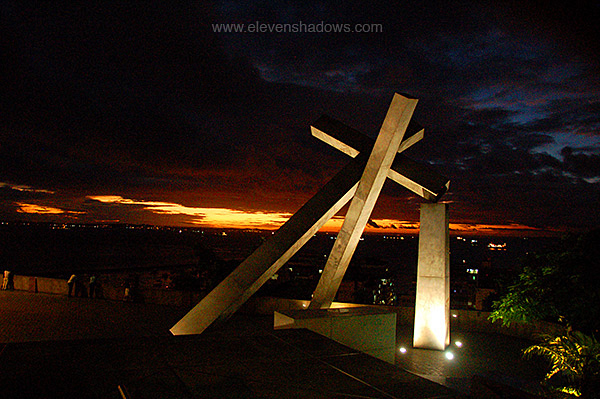 The
sun meeting the horizon at the Praça da Sé in the historic center of
Salvador da Bahia. The
sun meeting the horizon at the Praça da Sé in the historic center of
Salvador da Bahia. |
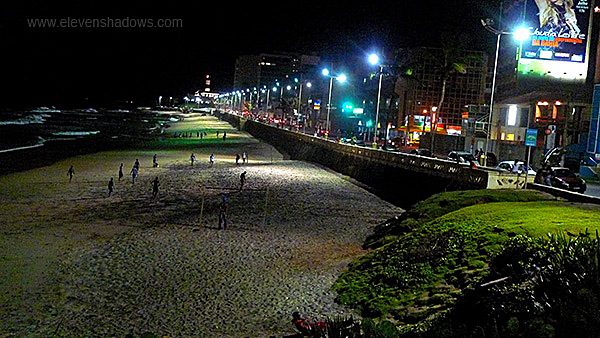 Later,
back in Barra, near the tip of Salvador where we were staying, Lisa and I
ate some delicious food, trying the moqueca de peixe, a tropical Brazilian
fish stew with coconut milk, which the region is known for. Two
delicious fish stew meals in one day. People played night football on
the beach as we ate. Later,
back in Barra, near the tip of Salvador where we were staying, Lisa and I
ate some delicious food, trying the moqueca de peixe, a tropical Brazilian
fish stew with coconut milk, which the region is known for. Two
delicious fish stew meals in one day. People played night football on
the beach as we ate. |
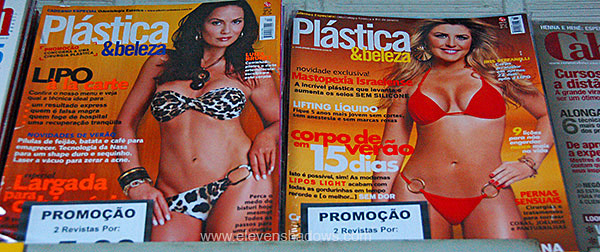 9
July Thursday - Lisa and I went to the main bus terminal, the Rodoviaria, to
catch a long-distance express bus to a very nice beach to the north, Praia
do Forte, which we were told was very safe by Alex. However, we had to
wait two hours for the bus, so we spent time in the various stores, where we
could catch up with the latest issues of Plástica & Beleza,
featuring the latest in plastic surgery. 9
July Thursday - Lisa and I went to the main bus terminal, the Rodoviaria, to
catch a long-distance express bus to a very nice beach to the north, Praia
do Forte, which we were told was very safe by Alex. However, we had to
wait two hours for the bus, so we spent time in the various stores, where we
could catch up with the latest issues of Plástica & Beleza,
featuring the latest in plastic surgery. |
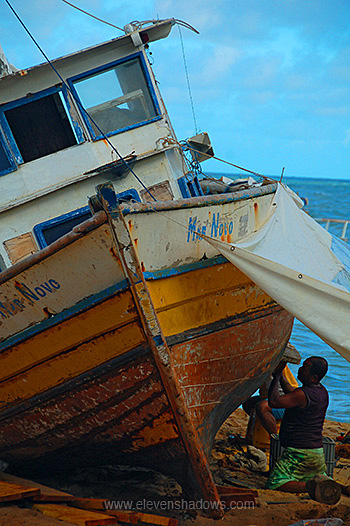 After
an almost two hour bus ride, we arrived in the middle of the afternoon at
Praia do Forte, a gorgeous upscale resort with plentiful tourist shops and
restaurants, fishing boats in the bay, a charming church, and
Projeto
TAMAR, dedicated to preserving endangered sea turtles. After
an almost two hour bus ride, we arrived in the middle of the afternoon at
Praia do Forte, a gorgeous upscale resort with plentiful tourist shops and
restaurants, fishing boats in the bay, a charming church, and
Projeto
TAMAR, dedicated to preserving endangered sea turtles.Praia do Forte showed its roots as a former rustic fishing village. However, it had been developed into an upscale, ecologically sensitive beach resort. |
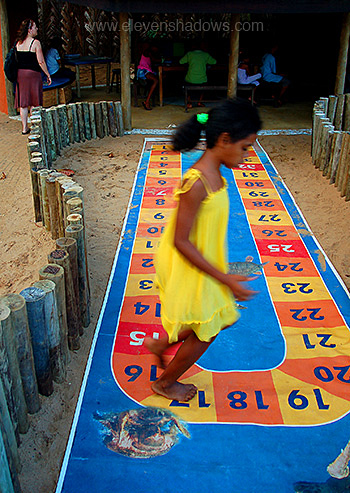 Sea
turtle hopscotch at
Projeto
TAMAR. Sea
turtle hopscotch at
Projeto
TAMAR. |
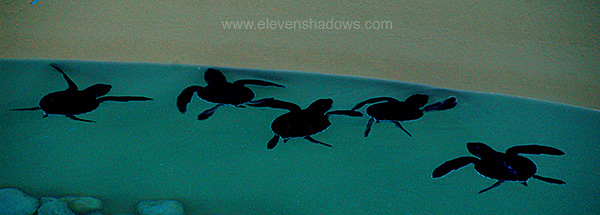 Projeto
TAMAR. Although initially concerned solely with sea turtles, the
project grew to include other sealife, as they are part of the environment
where the sea turtles live. Projeto
TAMAR. Although initially concerned solely with sea turtles, the
project grew to include other sealife, as they are part of the environment
where the sea turtles live. |
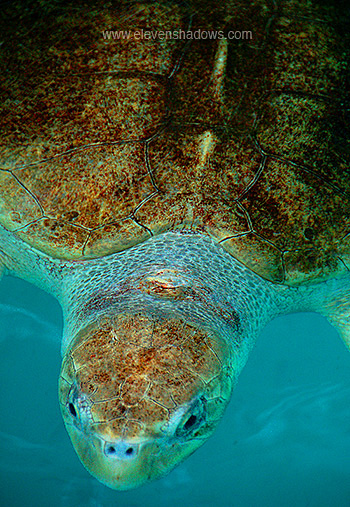 One
of the flourishing sea turtles at
Projeto
TAMAR. One
of the flourishing sea turtles at
Projeto
TAMAR. |
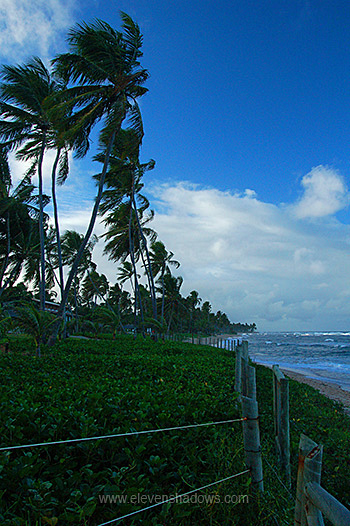 The
beautiful coastline of Praia do Forte, just to the north of
Projeto
TAMAR. Later in the trip,
I would return to Praia do
Forte, and walk 14 km (about 8.7 miles) to the next village along a virgin
beach. The
beautiful coastline of Praia do Forte, just to the north of
Projeto
TAMAR. Later in the trip,
I would return to Praia do
Forte, and walk 14 km (about 8.7 miles) to the next village along a virgin
beach. |
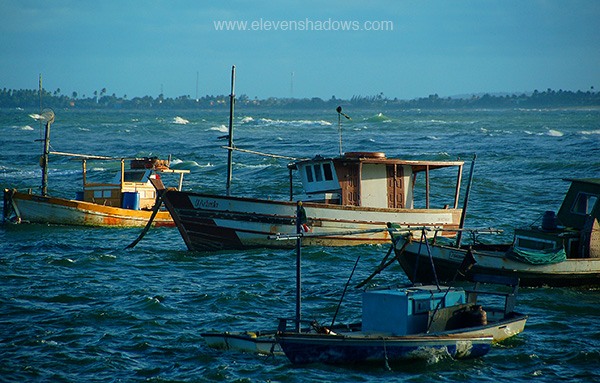 Fishing
boats at Praia do Forte, recalling its roots as a small fishing village
until its transformation into an upscale eco-resort. Fishing
boats at Praia do Forte, recalling its roots as a small fishing village
until its transformation into an upscale eco-resort. |
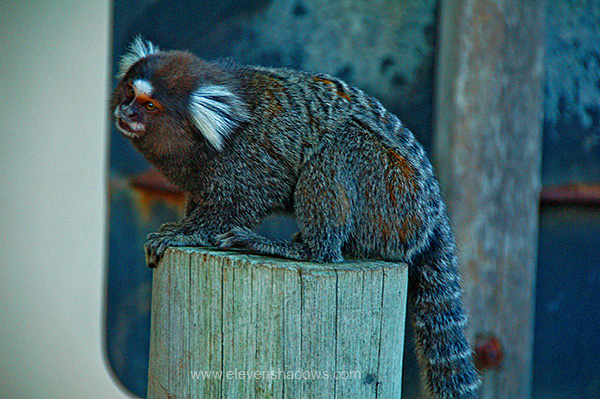 These
monkeys were all around Praia do Forte, and are a Black-tufted Marmoset, and
only live in Brazil. These
monkeys were all around Praia do Forte, and are a Black-tufted Marmoset, and
only live in Brazil. |
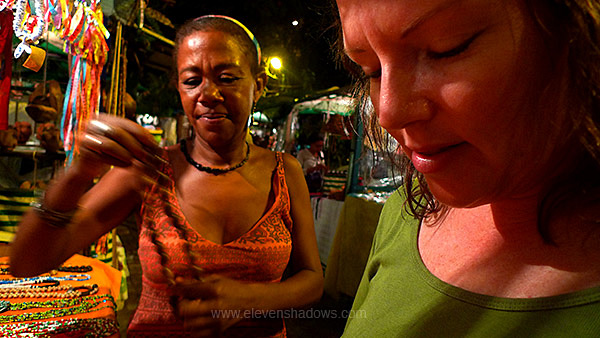 Shopping
in Praia do Forte before catching the last bus back to Salvador, where
guests Alex, Jaqueline, and guests Ken and Gillian were making caipirinhas,
the refreshing Brazilian drink made from cachaça, lime, ice, and liberal
amounts of sugar. Shopping
in Praia do Forte before catching the last bus back to Salvador, where
guests Alex, Jaqueline, and guests Ken and Gillian were making caipirinhas,
the refreshing Brazilian drink made from cachaça, lime, ice, and liberal
amounts of sugar. |
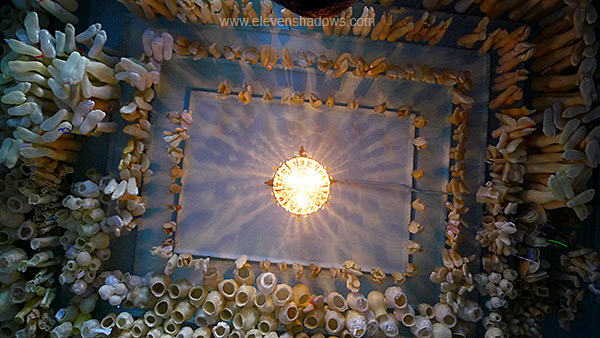 10
July Friday - Lisa and I visited Igreja do Bonfim, built in 1745.
The shrine is famous for its miraculous power to cure. Here on the
ceiling of the Sala de Milagres, we saw offerings, plastic replicas of feet,
arms, heads, hearts, representing the parts of the body that devotees claim
were healed. I hoped to return someday and hang a plastic
representation of my lower back here as an offering. 10
July Friday - Lisa and I visited Igreja do Bonfim, built in 1745.
The shrine is famous for its miraculous power to cure. Here on the
ceiling of the Sala de Milagres, we saw offerings, plastic replicas of feet,
arms, heads, hearts, representing the parts of the body that devotees claim
were healed. I hoped to return someday and hang a plastic
representation of my lower back here as an offering.This photo was taken by placing the Leica camera in the middle of the floor, pointing straight up at the ceiling. There's another photo similar to this taken when I returned for Sunday services nine days later. |
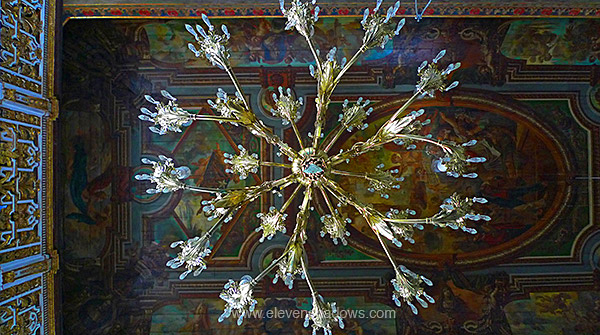 For
Afro-Brazilians who participate in Candomblé ceremonies, Bonfim is
the church of Oxala, the king of the orishas, whose name refers to spiritual
purity and light, and thus their most important church. But infused
with this is the Catholicism that the Portuguese imported to Brazil. For
Afro-Brazilians who participate in Candomblé ceremonies, Bonfim is
the church of Oxala, the king of the orishas, whose name refers to spiritual
purity and light, and thus their most important church. But infused
with this is the Catholicism that the Portuguese imported to Brazil.A chandelier in Igreja do Bonfim. |
Brazil: Amazon and Salvador da Bahia, July 2009
Page 8 of 17
1 2 3 4 5 6 7 8 9 10 11 12 13 14 15 16 17
EXTRA: Lisa's Photos and Videos of the Amazon
Eleven Shadows Travel Page
Contact photographer/musician Ken Lee